That makes sense - I will make sure to relay that to them. Thank you for all the wealth of info you've given me behind the scenes in our DMs!Tell the plaster rep that your pool water has a positive LSI (CSI is for TFP folks) and from the beginning. That means that the water wouldn't "suck" out the calcium from the plaster. On the other hand, poor plastering mixing and poor troweling does cause the calcium to bleed out naturally, and that is what causes the plaster to turn whitish, of which he is responsible for.
New Pool/Color Plaster Discolored and Rough. Can It Be Salvaged? Need Help With Options.
- Thread starter Pvlax4
- Start date
You are using an out of date browser. It may not display this or other websites correctly.
You should upgrade or use an alternative browser.
You should upgrade or use an alternative browser.
- May 3, 2014
- 62,674
- Pool Size
- 6000
- Surface
- Fiberglass
- Chlorine
- Salt Water Generator
- SWG Type
- Pentair Intellichlor IC-40
That was only from added calcium, or the pH/TA was kept too low and the calcium came from the plaster.I wonder why my CH reading was 550 two months after the initial fill.
Your pool's CH will be 1.5 to 2X higher after a year from the fresh fill. So going up 375 to 500 ppm CH over a years time.
For instance, my pool has had 7600 gallons added to it since last November. But using softened water, the CH has gone up by 50 ppm.
I don't know a ton about pools, but I know something about public water, and there's probably not much more than 20-100 gallons of stagnant water in that fire hydrant lead, depending on whether it's on the same side of the street as the main or across from it. Once that volume is flushed, the hydrant is flowing the same water that feeds your house, just a whole lot faster. That may stir up sediment, but the water won't be stagnant.Fire hydrant water is typically ugly. Stagnant. No reason whatsoever to not use tap water in Las Vegas for an initial fill.
Agreed though, why pay a truck to bring the same water from a fire hydrant across the street?
- May 3, 2014
- 62,674
- Pool Size
- 6000
- Surface
- Fiberglass
- Chlorine
- Salt Water Generator
- SWG Type
- Pentair Intellichlor IC-40
You are likely right, but when I see the FD here open the hydrant in front of our house each year, the water coming out is not clean.
And if they put a sock on the hydrant before flushing it, it's amazing what kind of debris it'll catch.You are likely right, but when I see the FD here open the hydrant in front of our house each year, the water coming out is not clean.
Calcium will naturally bleed out of poorly mixed plaster that also has a high amount of calcium chloride added to the plaster mix. That aspect is not well known in our industry.
Therefore, calcium increases of the pool water can occur for at least 5 different reasons. Aggressive water (low CSI), bad plaster mixing and application, adding tap water that replaces evaporated water, adding calcium hypochlorite (powdered chlorine shock), or adding calcium chloride to the water to intentionally raise the calcium level.
Therefore, calcium increases of the pool water can occur for at least 5 different reasons. Aggressive water (low CSI), bad plaster mixing and application, adding tap water that replaces evaporated water, adding calcium hypochlorite (powdered chlorine shock), or adding calcium chloride to the water to intentionally raise the calcium level.
Made a thread a few months ago regarding my new pool and gray plaster that developed white spotting and some roughness. Long story short, the pool builder said that's normal for colored plaster even though his initial reaction when he saw it was "that doesn't look right". I knew he would backtrack his statement. I wasn't even looking for a chip-out and replaster. I wanted them to polish/sand the plaster. The builder the best they could do was pay $1,500 of the $4,000 it would cost to polish the pool. They stated the price was at "cost" and the plastering company wouldn't be making money on the job, which I'm fairly certain that's not the case. It's not a large pool whatsoever - roughly 9,800 gallons.
I'm sick of the treatment and customer service and decided I may just try to tackle it myself. Unfortunately, I haven't seen many videos nor guides on the internet regarding the process.
Does anyone have recommendations on polishing tools and diamond grit pads? I was thinking of getting some 60 and 100 grit diamond pads. Not sure which company to get.
Any tips for when actually doing the polishing? Once complete, do I treat and go through the process of freshly laid plaster? For instance, sweep the plaster twice a day for two weeks, don't add salt and use the SWG for a month, along with not using the heater for a month? Any guidance would be greatly appreciated!
If anyone is curious, I attached some photos of the pool.
Fresh plaster
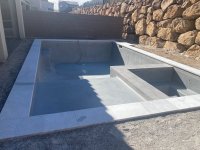
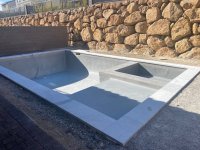
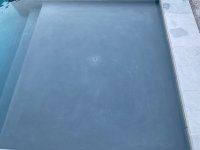
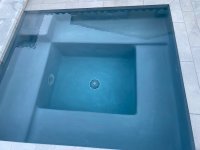
Plaster is 5 months old here

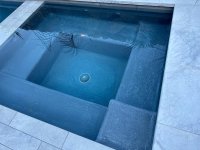
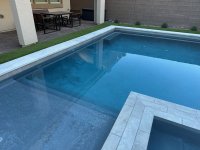
I'm sick of the treatment and customer service and decided I may just try to tackle it myself. Unfortunately, I haven't seen many videos nor guides on the internet regarding the process.
Does anyone have recommendations on polishing tools and diamond grit pads? I was thinking of getting some 60 and 100 grit diamond pads. Not sure which company to get.
Any tips for when actually doing the polishing? Once complete, do I treat and go through the process of freshly laid plaster? For instance, sweep the plaster twice a day for two weeks, don't add salt and use the SWG for a month, along with not using the heater for a month? Any guidance would be greatly appreciated!
If anyone is curious, I attached some photos of the pool.
Fresh plaster




Plaster is 5 months old here



- Jul 21, 2013
- 65,118
- Pool Size
- 35000
- Surface
- Plaster
- Chlorine
- Salt Water Generator
- SWG Type
- Pentair Intellichlor IC-60
See…
 www.troublefreepool.com
www.troublefreepool.com

 drptools.com
drptools.com
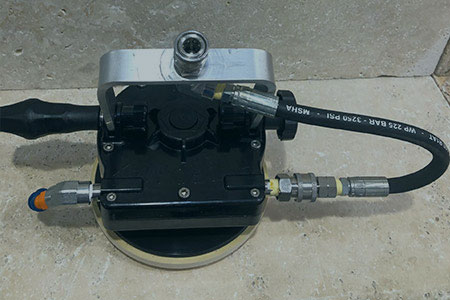
 coyoteabrasives.com
coyoteabrasives.com
No, you do not go through plaster curing startup process after polishing. Add water and add chemicals.
 www.troublefreepool.com
www.troublefreepool.com
Bad acid wash job. Can I fix it?
I had my pool/spa acid washed because there was some staining (I was already doing a complete drain and fill). The plaster is now a mess, it is very rough and traps dirt. I looks and feels terrible. I am thinking they left the acid on too long. I drained the spa and power washed and sanded...

Pool Plaster Diamond Disc
Looking for the perfect diamond disc to remove trowel marks and rough finishes from your pool plaster? Look no further than our Pool Plaster Diamond Disc store. Our non-corrosive Pool Plaster Diamond Discs are exclusively designed for use on pool plaster finishes and have been used since 1986...
 drptools.com
drptools.com

Hydrotorque Pool Polishers - Coyote Abrasives
Water driven pool finish polisher, Removes roughness, stains and polishes all aggregate pool finishes, Quartz, Pebble and Marble
No, you do not go through plaster curing startup process after polishing. Add water and add chemicals.
Just Filled Your Pool with Water? Here's What To Do Next - Further Reading
Last edited:
Exactly what I was looking for. Big help, thank you AJ! I looked at the Hydrotorque device before and it's just too expensive for polishing my pool a few times. Would totally invest in something like this if I had a business. I think I'm going to go with a Mikata wet/dry stone polisher.See…
Bad acid wash job. Can I fix it?
I had my pool/spa acid washed because there was some staining (I was already doing a complete drain and fill). The plaster is now a mess, it is very rough and traps dirt. I looks and feels terrible. I am thinking they left the acid on too long. I drained the spa and power washed and sanded...www.troublefreepool.com

Pool Plaster Diamond Disc
Looking for the perfect diamond disc to remove trowel marks and rough finishes from your pool plaster? Look no further than our Pool Plaster Diamond Disc store. Our non-corrosive Pool Plaster Diamond Discs are exclusively designed for use on pool plaster finishes and have been used since 1986...drptools.com

Hydrotorque Pool Polishers - Coyote Abrasives
Water driven pool finish polisher, Removes roughness, stains and polishes all aggregate pool finishes, Quartz, Pebble and Marblecoyoteabrasives.com
No, you do not go through plaster curing startup process after polishing. Add water and add chemicals.
Just Filled Your Pool with Water? Here's What To Do Next - Further Reading
www.troublefreepool.com
Thread Status
Hello , This thread has been inactive for over 60 days. New postings here are unlikely to be seen or responded to by other members. For better visibility, consider Starting A New Thread.

